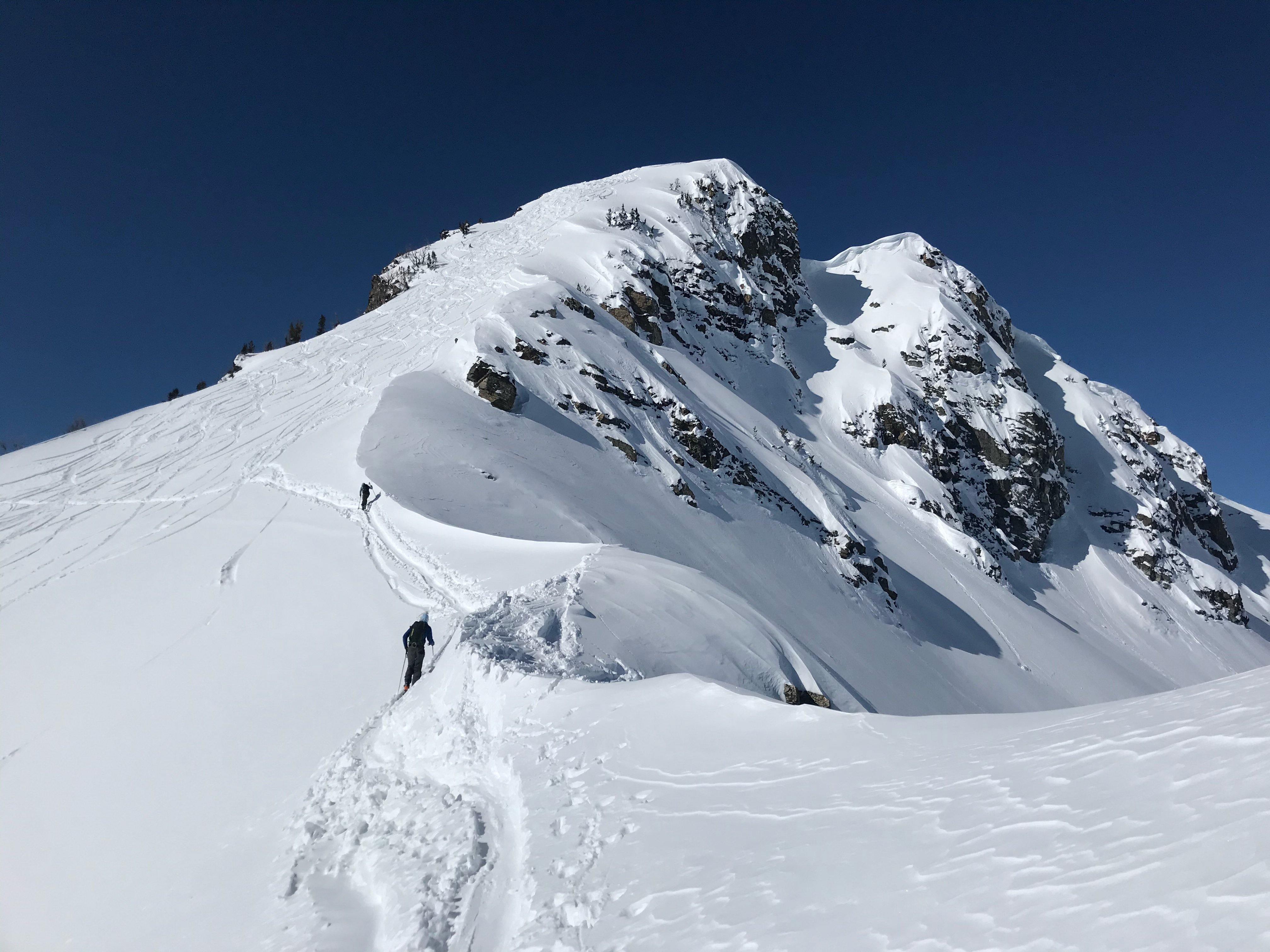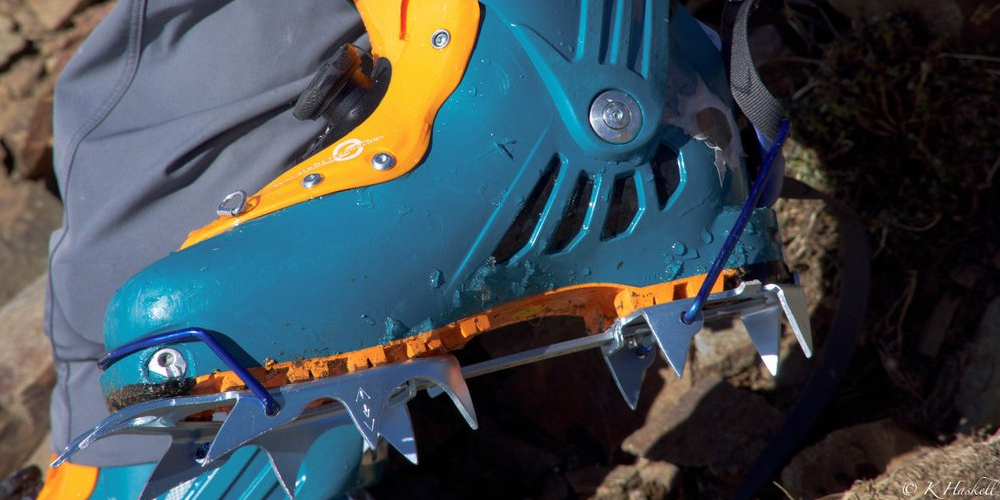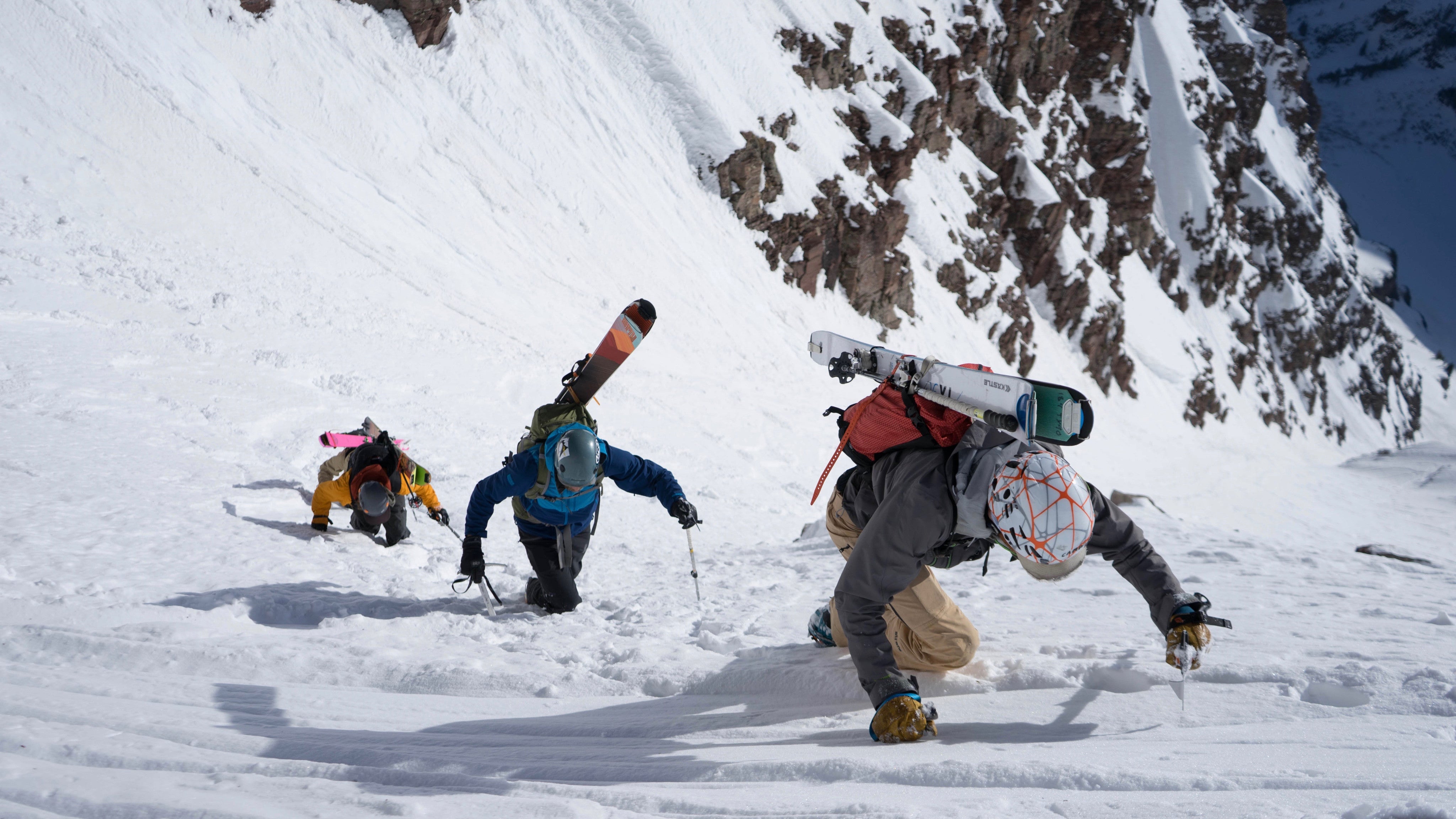Spring has arrived as we tilt towards the sun in the Northern Hemisphere. The seasonal change has a few effects on the snowpack. We get longer days and more significant warming from the sun. Often, with clear skies at night, the snowpack firms up, and it softens accordingly as the sun rises higher. In the spring, skiers/riders often depart the trailhead with headlamps to beat the heat and wait for softening snow atop their objective for the day. The firm snow might mean trickier ascending on skins alone. This is when we dip into the toolbox for what climbers or ski mountaineers refer to as the sharp and pointy things: crampons, axes, and ski crampons. Crampons, for example, allow for excellent traction on firm snow and ice. What might seem sketchy booting up without crampons becomes markedly easier with the spikes under your feet. Even in moderate terrain, all these spring mission tools come in handy for greater efficiency and safety. (But know how to use the tools properly, seek guidance if you are inexperienced). As spring opens up higher terrain and bigger objectives, the sharp and pointy things become an essential part of your daily equipment go-tos. Crampons Crampons are a great tool to provide security while bootpacking up snow and rock. When the slope is too steep for switchbacks, it’s time to bust out your crampons. Depending on the conditions and the surface you are traveling on, there are several options for crampons. The big decision to make with crampon selection is material type: aluminum or steel. Specifically, when we refer to aluminum or steel in the realm of ski mountaineering or spring skiing, most often we're talking about the front section. Aluminum CramponsAluminum crampons weigh less than steel, but are less durable. They work great for snow travel, but will wear significantly faster than steel equivalents when encountering rocky terrain. The Camp XLC 390 is a great aluminum crampon that weighs only 390 grams/pair. Steel CramponsSteel crampons are conversely heavier, but more robust. If you care about longevity more than weight-savings. Go with a steel crampon, this includes both a steel front and rear section. Steel crampons will also provide improved security when encountering icy terrain.Hybrid CramponsA goldilocks medium in between aluminum and steel is choosing a hybrid crampon. Hybrid crampons use steel in high use areas (the front section) and aluminum in other areas to save weight. These are a lightweight and durable option for ski mountaineering crampons. Several great options are out there including the Blue Ice Harfang, the Petzl Irvis Hyrbid, and the Camp XLC Nanotech which features an all aluminum design with riveted-on steel frontpoints. CompatibilityOnce you narrow down the material you need, it's important to make sure that the crampons are compatible with your boots. If you have a toe welt like a standard alpine ski boot, you'll want automatic crampons. Automatic crampons have metal toe and heel bails. Toe and heel bails provide the most secure connection for crampons. If you don't have a toe welt (Dynafit TLT7, Hoji Pro Tour, PDG 2, etc.), you will need a semiautomatic crampon. These crampons have a plastic toe bail and metal heel bail. Another option is to buy the proprietary Dynafit Cramp-In aluminum crampons for these boots. The most important consideration for crampon compatibility is to size you crampons at home. Make sure they have a snug, secure fit before entering consequential terrain in the backcountry. Snow Tools Snow/Ice axes provide protection in steep, firm terrain. Ideally, an axe provides solid placements when swinging the axe in more technical terrain or using as a walking cane. In the event of a fall, they provide a method for self-arrest. Just like crampons, ice axes are made of both steel and aluminum. The shafts are aluminum, whereas the picks are steel or aluminum, or in some cases, titanium. Steel is more durable but heavier; aluminum is lighter but less secure when encountering rock or ice. Another consideration are the picks. More aggressive picks, like we see on the Blue Ice Akila, works better on ice, whereas a more curved pick, performs better in snow. The Camp Ice tool series provides both a featherweight aluminum version (Corsa) and a more robust steel version (Corsa Alpine). For those really counting the grams, the Hummingbird from Blue Ice is feather light at 200g. Ski Crampons Unlike boot crampons, ski crampons are only made out of aluminum and there are fewer variations. You should make sure that the ski crampons are compatible with your binding before buying. They are used when skinning up a steep slope that is too firm to maintain adequate purchase with your ski edges. CCBC Head Barista Doug says it best: “Ski crampons can be likened to putting chains on a truck and settling into four-wheel drive low. That said, their application is minimal but crucial.” Well phrased Doug. Make sure that your ski crampons are slightly wider than your ski's waist width, but too big and you risk breaking your binding from the subsequent torque of ski crampon to binding leverage. Other Ski Mountaineering Gear Here are a few more items to keep in mind when packing for a day of ski mountaineering:Dual-rated helmet (climbing and skiing) to protect you from rockfalls and stray beers.Full-coverage sunglasses for both wind and sun protection and the steezy après scenes.Skin and ski wax can help prevent 'globbing' from hot, water-saturated snow that can be found on surfaces with warming temps Let us know if you have any other go-to items for ski mountaineering missions in the comments below. Stay safe out there.

Spring Ski Mountaineering Essential Gear
Each year, spring arrives as the earth tilts toward the sun in the Northern Hemisphere. This seasonal change brings with it longer days and more significant warming from the sun that has a few effects on the snowpack. With clear skies at night, the snowpack firms up and softens accordingly as the sun rises higher each day. In the spring, skiers and riders often need to depart the trailhead with headlamps to beat the heat and wait for softening snow atop their objective for the day. The firm snow might mean trickier ascending on skins alone. This is when we dip into the toolbox for what climbers or ski mountaineers refer to as the sharp and pointy things: crampons, axes, and ski crampons.
Crampons, for example, allow for excellent traction on firm snow and ice. A bullet-proof slope that might seem sketchy booting up without crampons becomes markedly easier with the spikes under your feet. Even in moderate terrain, all these spring mission tools come in handy for greater efficiency and safety. (But know how to use the tools properly, seek guidance if you are inexperienced).
As spring opens up higher terrain and bigger objectives, the sharp and pointy things become an essential part of your daily equipment go-tos.
Crampons


Crampons are a great tool for providing security while bootpacking up snow and rock. When the slope is too steep for switchbacks, it's time to bust out your crampons. Depending on the conditions and the surface you are traveling on, there are several options for crampons. The big decision to make with crampon selection is material type: aluminum or steel. Specifically, when we refer to aluminum or steel in ski mountaineering or spring skiing, most often, we're talking about the front section.
Aluminum Crampons
Aluminum crampons weigh less than steel, but are less durable. They work great for snow travel, but will wear significantly faster than steel equivalents when encountering rocky terrain. The Camp XLC 390 is a great aluminum crampon that weighs only 390 grams/pair.
Steel Crampons
Steel crampons are heavier than aluminum, but more robust. If you care about longevity more than weight-savings, go with a steel crampon (including options that have both a steel front and rear section. Steel crampons will also provide improved security when encountering icy terrain.
Hybrid Crampons
Hybrid crampons are a goldilocks medium between aluminum and steel. Hybrid crampons use steel in high use areas (the front section) and aluminum in other areas to save weight. These are a lightweight and durable option for ski mountaineering crampons. Several great options are out there including the Blue Ice Harfang, the Petzl Irvis Hyrbid, and the Camp XLC Nanotech which features an all aluminum design with riveted-on steel frontpoints.
Compatibility
Once you narrow down the material you need, ensuring the crampons are compatible with your boots is important. You'll want automatic crampons if you have a toe welt like a standard alpine ski boot. Automatic crampons have metal toe and heel bails. Toe and heel bails provide the most secure connection for crampons. If you don't have a toe welt (Dynafit TLT7, Hoji Pro Tour, PDG 2, etc.), you will need a semiautomatic crampon. These crampons have a plastic toe bail and metal heel bail. Another option is to buy the proprietary Dynafit Cramp-In aluminum crampons for these boots.
The most important consideration for crampon compatibility is to size you crampons at home. Make sure they have a snug, secure fit before entering consequential terrain in the backcountry.
Snow Tools


Snow/Ice axes provide protection in steep, firm terrain. Ideally, an axe provides solid placements when swinging in more technical terrain or is used as a walking cane. In the event of a fall, they provide a method for self-arrest. Just like crampons, ice axes are made of both steel and aluminum. The shafts are aluminum, whereas the picks are steel or aluminum, or in some cases, titanium. Steel is more durable but heavier; aluminum is lighter but less secure when encountering rock or ice. Another consideration are the picks. More aggressive picks, like we see on the Blue Ice Akila, work better on ice, whereas a more curved pick performs better in snow. The Camp Ice tool series provides a featherweight aluminum version (Corsa) and a more robust steel version (Corsa Alpine). For those really counting the grams, the Hummingbird from Blue Ice is feather-light at 200g.
Ski Crampons
Unlike boot crampons, ski crampons are made only of aluminum, with fewer variations. Before buying, you should ensure the ski crampons are compatible with your binding. Use ski crampons when skinning up a steep slope too firm to maintain adequate purchase with your ski edges. CCBC Head Barista Doug says it best: “Ski crampons can be likened to putting chains on a truck and settling into four-wheel drive low. That said, their application is minimal but crucial.” Well phrased, Doug. Ensure that your ski crampons are slightly wider than your ski's waist width but not so wide that you risk breaking your binding from the subsequent torque of the ski crampon to binding leverage.
Other Ski Mountaineering Gear
Here are a few more items to keep in mind when packing for a day of ski mountaineering:
- Dual-rated helmet (climbing and skiing) to protect you from rockfalls and stray beers.
- Full-coverage sunglasses for both wind and sun protection and the steezy apres scenes.
- Skin and ski wax to prevent globbing from hot, water-saturated surface snow.
Let us know if you have any other go-to items for ski mountaineering missions and stay safe out there.



